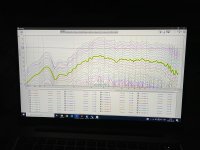It will be all similar and these waveguides are pretty forgiving regarding a crossover frequency. I didn't give up on the cardioid at all, I just have a lot of different projects running...But you're going to use an 18" woofer with ATHEX460? I'm interested in the real life compromises of going with a 15 or even a 12. Did you give up on Cardioid for lower mid/ upper bass?
Sorry, I can't show you 🙂Can you give a clue how you went about calculating this? I've seen the sketches in F360 but I can't think of an easy way of working out the transitions. I've rather fudged the issue in the past.
It's just that the profile parameters are modified in all the different radial directions so it matches smoothly the petal sheet as a result. I decided to keep this proprietary.
Last edited:
What happen when you scale down the st-260 and ad a roundish back chamber/cabinet and taps for a 4” midrange cone?
I know..
I used the st-260 scaled it down to a 12mm throat, modified the back and fitted it on a cheap 4” coaxial from Thomann in house brand The Box.
The coaxial has a cylindrical hole thru the midrange motor structure and originally a small horn for the tiny compression driver.
I added ~ 4cm open cell foam in the cylindrical part near the throat of the waveguide that cleaned up some peaks and valleys for both of the drivers frequency response .
And from yesterdays measurement. I think this fun experiment can become something useful. Or not, it’s all for fun anyway.
I always wanted to try Danley’ solution for adding a coaxial as part of a synergy horn but my printer bed is limited. Ergo I fiddled with a tiny coaxial and accept the limitations.
I apologize for the snapshots of the measurement but the time ran out. The battery on the laptop died as I was about to hear the first actual music. Literally pushed play and it died..
Side note: it’s only a 6ms window, no smoothing. Bad measurement conditions.
I know..
I used the st-260 scaled it down to a 12mm throat, modified the back and fitted it on a cheap 4” coaxial from Thomann in house brand The Box.
The coaxial has a cylindrical hole thru the midrange motor structure and originally a small horn for the tiny compression driver.
I added ~ 4cm open cell foam in the cylindrical part near the throat of the waveguide that cleaned up some peaks and valleys for both of the drivers frequency response .
And from yesterdays measurement. I think this fun experiment can become something useful. Or not, it’s all for fun anyway.
I always wanted to try Danley’ solution for adding a coaxial as part of a synergy horn but my printer bed is limited. Ergo I fiddled with a tiny coaxial and accept the limitations.
I apologize for the snapshots of the measurement but the time ran out. The battery on the laptop died as I was about to hear the first actual music. Literally pushed play and it died..
Side note: it’s only a 6ms window, no smoothing. Bad measurement conditions.
Attachments
-
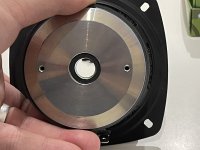 IMG_8943.jpeg260.7 KB · Views: 289
IMG_8943.jpeg260.7 KB · Views: 289 -
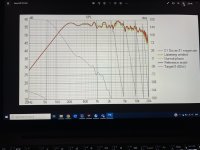 IMG_2170.jpeg407.3 KB · Views: 287
IMG_2170.jpeg407.3 KB · Views: 287 -
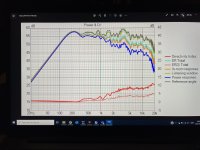 IMG_2169.jpeg399.8 KB · Views: 290
IMG_2169.jpeg399.8 KB · Views: 290 -
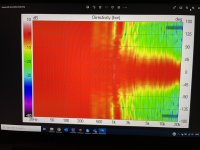 IMG_2167.jpeg385.3 KB · Views: 288
IMG_2167.jpeg385.3 KB · Views: 288 -
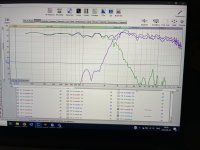 IMG_2164.jpeg432.6 KB · Views: 293
IMG_2164.jpeg432.6 KB · Views: 293 -
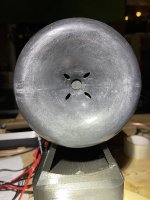 IMG_2158.jpeg513.5 KB · Views: 295
IMG_2158.jpeg513.5 KB · Views: 295 -
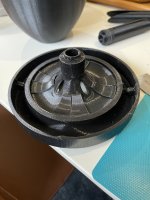 IMG_2138.jpeg468.8 KB · Views: 293
IMG_2138.jpeg468.8 KB · Views: 293 -
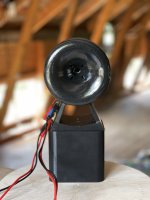 IMG_1989.jpeg261.4 KB · Views: 316
IMG_1989.jpeg261.4 KB · Views: 316 -
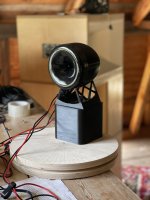 IMG_1988.jpeg352.8 KB · Views: 315
IMG_1988.jpeg352.8 KB · Views: 315 -
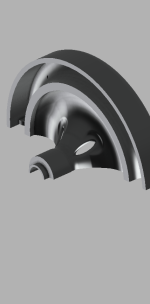 IMG_1981.png46.5 KB · Views: 299
IMG_1981.png46.5 KB · Views: 299 -
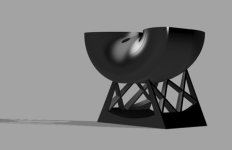 Bild 2023-07-23 kl. 14.08.jpeg11.6 KB · Views: 290
Bild 2023-07-23 kl. 14.08.jpeg11.6 KB · Views: 290 -
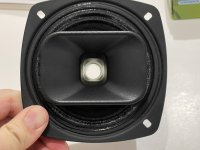 IMG_8941.jpeg336.4 KB · Views: 271
IMG_8941.jpeg336.4 KB · Views: 271 -
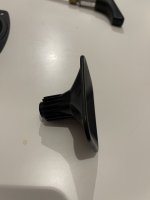 IMG_8946.jpeg247.2 KB · Views: 267
IMG_8946.jpeg247.2 KB · Views: 267 -
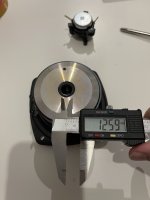 IMG_8949.jpeg265.1 KB · Views: 295
IMG_8949.jpeg265.1 KB · Views: 295 -
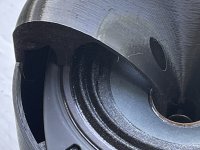 IMG_1756.jpeg450.7 KB · Views: 272
IMG_1756.jpeg450.7 KB · Views: 272 -
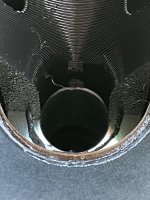 IMG_1754.jpeg381.5 KB · Views: 276
IMG_1754.jpeg381.5 KB · Views: 276 -
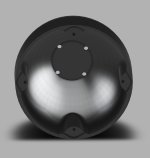 IMG_1757.jpeg88 KB · Views: 268
IMG_1757.jpeg88 KB · Views: 268 -
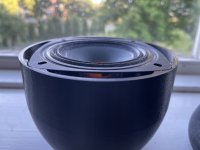 IMG_1798.jpeg282.2 KB · Views: 284
IMG_1798.jpeg282.2 KB · Views: 284
The HF response is surprisingly smooth. Could be due to the tiny size. It would be interesting to compare it with the original coaxial.
Now make it bigger 🙂
Now make it bigger 🙂
Got my eye on a bigger coaxial if I ever get a bigger printer and that’s the Redcatt 6” https://redcatt.de/REDCATT-CX601X8
On the manufacturers site they even provide 3d-files so it simply a matter of making a fitting cone that buts up again there “throat cone”
Then the compression driver is more capable but as you said bigger throat size.
The raw response of the tweeter is actually quite impressive and linear. The attached is with the foam in place, without the foam it’s actually linear to 20kHz
On the manufacturers site they even provide 3d-files so it simply a matter of making a fitting cone that buts up again there “throat cone”
Then the compression driver is more capable but as you said bigger throat size.
The raw response of the tweeter is actually quite impressive and linear. The attached is with the foam in place, without the foam it’s actually linear to 20kHz
Attachments
It seems this has a great potential, especially considering the (relative) simplicity. Perhaps a lower-DI waveguide could be used.
Again, congratulations to a great achievement.
- Did you consider making the midrange a cardioid (with side ports) to increase the DI in the mid band? That would be an insane construction for its size.
Again, congratulations to a great achievement.
- Did you consider making the midrange a cardioid (with side ports) to increase the DI in the mid band? That would be an insane construction for its size.
I don't think you would need a more capable driver if you can keep the XO this high without any issues...[...] Then the compression driver is more capable but as you said bigger throat size.
Last edited:
An ATHEX 460-25 would be great.
Thanks for all your hard work and dedication, making ATH software and documentation publicly available. Which takes tremendous time and effort, much appreciated. I'll be more than happy to make a donation. Thanks so much Marcel.
Thanks for all your hard work and dedication, making ATH software and documentation publicly available. Which takes tremendous time and effort, much appreciated. I'll be more than happy to make a donation. Thanks so much Marcel.
Last edited:
Absolutely, it’s been on my mind since the D&D 8c showed its controlled dispersion. And now I got a nice platform to play with.- Did you consider making the midrange a cardioid (with side ports) to increase the DI in the mid band? That would be an insane construction for its size.
Toxic traits make one think that I can do it equally good.
I also considered making a version of linkwitz lx-mini that would simply offset the driver and waveguide out from the back chamber. And fill it completely with melamine foam.
But first a simple removal of the back chamber and measure the effect of the midrange in an open back configuration.
This is so cool! Congratulations!What happen when you scale down the st-260 and ad a roundish back chamber/cabinet and taps for a 4” midrange cone?
I know..
I used the st-260 scaled it down to a 12mm throat, modified the back and fitted it on a cheap 4” coaxial from Thomann in house brand The Box.
The coaxial has a cylindrical hole thru the midrange motor structure and originally a small horn for the tiny compression driver.
I added ~ 4cm open cell foam in the cylindrical part near the throat of the waveguide that cleaned up some peaks and valleys for both of the drivers frequency response .
And from yesterdays measurement. I think this fun experiment can become something useful. Or not, it’s all for fun anyway.
I always wanted to try Danley’ solution for adding a coaxial as part of a synergy horn but my printer bed is limited. Ergo I fiddled with a tiny coaxial and accept the limitations.
I apologize for the snapshots of the measurement but the time ran out. The battery on the laptop died as I was about to hear the first actual music. Literally pushed play and it died..
Side note: it’s only a 6ms window, no smoothing. Bad measurement conditions.
Great, that was quick.Would this be OK?
Is the exit angle of a TD-2001 8 degrees (full angle)?
If possible could you tweak the exit angle for TD2001 full 3.6 degrees?
Thanks Marcel
That's no problem, but are you sure? The available drawings show ~8 degrees (?). Isn't it maybe 2 x 3.6? - that could be.
...I just kept pressing the "Print again" button (and ran out of blue filament)... 🙂

(460-36)
(460-36)
I searched and found the exit angle in this forum whgeiger mentioned it was 3.6.That's no problem, but are you sure? The available drawings show ~8 degrees (?). Isn't it maybe 2 x 3.6? - that could be.
We'll go with yours as you have the drawings. I believe what you have is more accurate. Thanks
- Home
- Loudspeakers
- Multi-Way
- Acoustic Horn Design – The Easy Way (Ath4)
